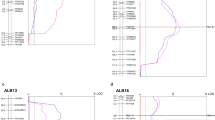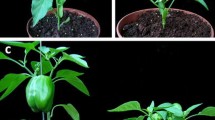Abstract
Key message
A major gene controls flowering pattern in peanut, possibly encoding a TFL1-like. It was subjected to gain/loss events of a deletion and changes in mRNA expression levels, partly explaining the evolution of flowering pattern in Arachis.
Abstract
Flowering pattern (FP) is a major characteristic differentiating the two subspecies of cultivated peanut (Arachis hypogaea L.). Subsp. fastigiata possessing flowers on the mainstem (MSF) and a sequential FP, whereas subsp. hypogaea lacks MSF and exhibits an alternate FP. FP is considered the main contributor to plant adaptability, and evidence indicates that its diversification occurred during the several thousand years of domestication. However, the genetic mechanism that controls FP in peanut is unknown. We investigated the genetics of FP in a recombinant inbred population, derivatives of an A. hypogaea by A. fastigiata cross. Lines segregated 1:1 for FP, indicating a single gene effect. Using Axiom_Arachis2 SNP-array, FP was mapped to a small segment in chromosome B02, wherein a Terminal Flowering 1-like (AhTFL1) gene with a 1492 bp deletion was found in the fastigiata line, leading to a truncated protein. Remapping FP in the RIL population with the AhTFL1 indel as a marker increased the LOD score from 53.3 to 158.8 with no recombination in the RIL population. The same indel was found co-segregating with the phenotype in two independent EMS-mutagenized M2 families, suggesting a hotspot for gene conversion. Also, AhTFL1 was significantly less expressed in the fastigiata line compared to hypogaea and in flowering than non-flowering branches. Sequence analysis of the AhTFL1 in peanut world collections indicated significant conservation, supporting the putative role of AhTFL1 in peanut speciation during domestication and modern cultivation.




Similar content being viewed by others
Data availability
All the data is directly available from the main manuscript and the supplementary files.
References
Bertioli DJ, Cannon SB, Froenicke L, Huang G, Farmer AD, Cannon EK, Liu X, Gao D, Clevenger J, Dash S (2016) The genome sequences of Arachis duranensis and Arachis ipaensis, the diploid ancestors of cultivated peanut. Nat Genet 48:438–446. https://doi.org/10.1038/ng.3517
Bertioli DJ, Jenkins J, Clevenger J, Dudchenko O, Gao D, Seijo G, Leal-Bertioli SC, Ren L, Farmer AD, Pandey MK (2019) The genome sequence of segmental allotetraploid peanut Arachis hypogaea. Nat Genet 51:877–884. https://doi.org/10.1038/s41588-019-0405-z
Bertioli DJ, Abernathy B, Seijo G, Clevenger J, Cannon SB (2020) Evaluating two different models of peanut’s origin. Nat Genet 52:557–559. https://doi.org/10.1038/s41588-020-0626-1
Blackman BK, Strasburg JL, Raduski AR, Michaels SD, Rieseberg LH (2010) The role of recently derived FT paralogs in sunflower domestication. Curr Biol 20:629–635. https://doi.org/10.1016/j.cub.2010.01.059
Chavarro C, Chu Y, Holbrook C, Isleib T, Bertioli D, Hovav R, Butts C, Lamb M, Sorensen R, Jackson SA, Ozias-Akins P (2020) Pod and seed trait QTL identification to assist breeding for peanut market preferences. G3 Genes Genomes Genet 10:2297–2315. https://doi.org/10.1534/g3.120.401147
Chopra R, Simpson CE, Hillhouse A, Payton P, Sharma J, Burow MD (2018) SNP genotyping reveals major QTLs for plant architectural traits between A-genome peanut wild species. Mol Genet Genomic 293:1477–1491. https://doi.org/10.1007/s00438-018-1472-z
Chu Y, Chee P, Isleib TG, Holbrook CC, Ozias-Akins P (2020) Major seed size QTL on chromosome A05 of peanut (Arachis hypogaea) is conserved in the US mini core germplasm collection. Mol Breed 40:1–16. https://doi.org/10.1007/s11032-019-1082-4
Clevenger J, Chu Y, Scheffler B, Ozias-Akins P (2016) A developmental transcriptome map for allotetraploid Arachis hypogaea. Front Plant Sci 7:1446. https://doi.org/10.3389/fpls.2016.01446
Clevenger JP, Korani W, Ozias-Akins P, Jackson S (2018) Haplotype-based genotyping in polyploids. Front Plant Sci 9:564. https://doi.org/10.3389/fpls.2018.00564
Dash S, Cannon EKS, Kalberer SR, Farmer AD, Cannon SB (2016) PeanutBase and other bioinformatic resources for peanut. In: Stalker HT, Wilson RF (eds) Peanuts genetics, processing and utilization. AOCS Press, pp 241–252. https://doi.org/10.1016/B978-1-63067-038-2.00008-3
FAOSTAT (2019) Production quantities of groundnuts, with shell by country. FAO Food and Agriculture Organization of the United Nations, Rome, Italy. http://www.fao.org/faostat/en/#data/QC/visualize
Hammons RO (1971) Inheritance of inflorescences in main stem leaf axils in Arachis hypogaea L. Crop Sci 11:570–571. https://doi.org/10.2135/cropsci1971.0011183X001100040034x
Hanano S, Goto K (2011) Arabidopsis TERMINAL FLOWER1 is involved in the regulation of flowering time and inflorescence development through transcriptional repression. Plant Cell 23:3172–3184. https://doi.org/10.1105/tpc.111.088641
Hovav R, Hedvat I (2011) The development and screening of Hanoch-based EMS peanut population. Scientific report submitted to IGPB (Hebrew), 1–11
Jin H, Tang X, Xing M, Zhu H, Sui J, Cai C, Li S (2019) Molecular and transcriptional characterization of phosphatidyl ethanolamine-binding proteins in wild peanuts Arachis duranensis and Arachis ipaensis. BMC Plant Biol 19:1–16. https://doi.org/10.1186/s12-019-2113-3
Kojima S, Takahashi Y, Kobayashi Y, Monna L, Sasaki T, Araki T, Yano M (2002) Hd3a, a rice ortholog of the Arabidopsis FT gene, promotes transition to flowering downstream of Hd1 under short-day conditions. Plant Cell Physiol 43:1096–1105
Korani W, Clevenger JP, Chu Y, Ozias-Akins P (2019) Machine learning as an effective method for identifying true single nucleotide polymorphisms in polyploid plants. Plant Genome 12:180023. https://doi.org/10.3835/plantgenome2018.05.0023
Krapovickas A, Gregory WC, Williams DE, Simpson CE (2007) Taxonomy of the genus Arachis (Leguminosae). Bonplandia 16:7–205. https://www.jstor.org/stable/41941433
Krapovickas A, Vanni RO (2009) El maní de Llullaillaco. Bonplandia 18:51–55. https://doi.org/10.30972/bon.1811347
Kvien CK, Ozias-Akins P (1991) Lack of monocarpic senescence in florunner peanut. Peanut Sci 18:86–90. https://doi.org/10.3146/i0095-3679-18-2-6
Kwak M, Velasco D, Gepts P (2008) Mapping homologous sequences for determinacy and photoperiod sensitivity in common bean (Phaseolus vulgaris). J Hered 99:283–291. https://doi.org/10.1093/jhered/esn005
Liu B, Watanabe S, Uchiyama T, Kong F, Kanazawa A, Xia Z, Nagamatsu A, Arai M, Yamada T, Kitamura K, Masuta C (2010) The soybean stem growth habit gene Dt1 is an ortholog of Arabidopsis TERMINAL FLOWER1. Plant Physiol 153:198–210. https://doi.org/10.1104/pp.109.150607
McGarry RC, Ayre BG (2012) Manipulating plant architecture with members of the CETS gene family. Plant Sci 188:71–81. https://doi.org/10.1016/j.plantsci.2012.03.002
McGarry RC, Prewitt SF, Culpepper S, Eshed Y, Lifschitz E, Ayre BG (2016) Monopodial and sympodial branching architecture in cotton is differentially regulated by the Gossypium hirsutum SINGLE FLOWER TRUSS and SELF-PRUNING orthologs. New Phytol 212:244–258. https://doi.org/10.1111/nph.14037
Moretzsohn MC, Gouvea EG, Inglis PW, Leal-Bertioli SC, Valls JF, Bertioli DJ (2013) A study of the relationships of cultivated peanut (Arachis hypogaea) and its most closely related wild species using intron sequences and microsatellite markers. Ann Bot 111:113–126. https://doi.org/10.1093/aob/mcs237
Van Ooijen JW (2006) JoinMap® 4, Software for the calculation of genetic linkage maps in experimental populations. Kyazma BV, Wageningen, 33(10.1371)
Van Ooijen JW (2009) MapQTL 6. Genome
Parmentier-Line CM, Coleman GD (2016) Constitutive expression of the Poplar FD-like basic leucine zipper transcription factor alters growth and bud development. Plant Biotechnol J 14:260–270. https://doi.org/10.1111/pbi.12380
Patil AS, Popovsky S, Levy Y, Chu Y, Clevenger J, Ozias-Akins P, Hovav R (2018) Genetic insight and mapping of the pod constriction trait in Virginia-type peanut. BMC Genet 19:1–9. https://doi.org/10.1186/s12863-018-0674-z
Pittman RN (1995) United States peanut descriptors. ARS (USA). https://agris.fao.org/agris-search/search.do?recordID=US9560075
Samoluk SS, Chalup L, Robledo G, Seijo JG (2015) Genome sizes in diploid and allopolyploid Arachis L. species (section Arachis). Genet Resour Crop Evol 62:747–763. https://doi.org/10.1007/s10722-014-0193-3
Sega GA (1984) A review of the genetic effects of ethyl methanesulfonate. Mut Res/reviews in Genet Toxicol 134:113–142. https://doi.org/10.1016/0165-1110(84)90007-1
Shalit A, Rozman A, Goldshmidt A, Alvarez JP, Bowman JL, Eshed Y, Lifschitz E (2009) The flowering hormone florigen functions as a general systemic regulator of growth and termination. Proc Natl Acad Sci 106:8392–8397. https://doi.org/10.1073/pnas.0810810106
Stalker HT, Simpson CE (1995) Gerplasm resources in Arachis in advances in peanut science. In: Patee HE, Stalker HT (ed) American Peanut Research and Education Society, pp 14–55
Tian Z, Wang X, Lee R, Li Y, Specht JE, Nelson RL, McClean PE, Qiu L, Ma J (2010) Artificial selection for determinate growth habit in soybean. Proc Natl Acad Sci 107:8563–8568. https://doi.org/10.1073/pnas.1000088107
Voorrips R (2002) MapChart: software for the graphical presentation of linkage maps and QTLs. J Hered 93:77–78. https://doi.org/10.1093/jhered/93.1.77
Wynne JC (1975) Inheritance of branching pattern in Arachis hypogaea L. Peanut Sci 2:1–5. https://doi.org/10.3146/i0095-3679-2-1-1
Zhuang W, Chen H, Yang M, Wang J, Pandey MK, Zhang C, Chang WC, Zhang L, Zhang X, Tang R (2019) The genome of cultivated peanut provides insight into legume karyotypes, polyploid evolution and crop domestication. Nat Genet 51:865–876. https://doi.org/10.1038/s41588-019-0402-2
Acknowledgements
The authors express heartfelt gratitude to Yehonatan Halevy for his support in the field data collection.
Funding
This study was funded by the Israeli Ministry of Agriculture (Grant No. 200) and an Israel-USA Bilateral Agriculture Research and Development (BARD) Grant (Grant No. IS-5020-17). The funders did not have any scientific part in the study.
Author information
Authors and Affiliations
Contributions
RH and PO-A are the PI and Co-PI of this project, respectively. SK is the leading student that performed the work and wrote the manuscript. YC, AH and SA helped with data analyses and writing the paper. YL helped with the laboratory work.
Corresponding author
Ethics declarations
Conflict of interest
The authors declare that they have not conflict of interest.
Ethical approval
The authors declare that the work was original research that has not been published previously, and is not under consideration for publication elsewhere.
Additional information
Communicated by Janila Pasupuleti.
Publisher's Note
Springer Nature remains neutral with regard to jurisdictional claims in published maps and institutional affiliations.
Supplementary Information
Below is the link to the electronic supplementary material.
Rights and permissions
About this article
Cite this article
Kunta, S., Chu, Y., Levy, Y. et al. Identification of a major locus for flowering pattern sheds light on plant architecture diversification in cultivated peanut. Theor Appl Genet 135, 1767–1777 (2022). https://doi.org/10.1007/s00122-022-04068-1
Received:
Accepted:
Published:
Issue Date:
DOI: https://doi.org/10.1007/s00122-022-04068-1




